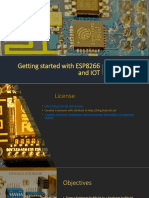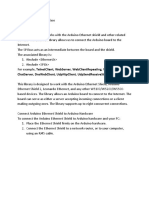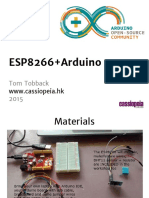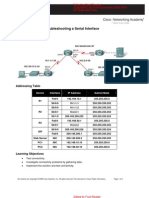Esp8266 Based Serial Wifi Shield For Arduino User
Uploaded by
JonathanDaysEsp8266 Based Serial Wifi Shield For Arduino User
Uploaded by
JonathanDaysESP8266-Based
Serial WiFi Shield for Arduino----User Manual
Table of Contents
1. Introduction
2. Technical Specifications
3. Dimensions
4. Interface Definition and LED Definition
5. Quick Start
6. Configuration Introduction
7. Sell Link and Technical Services
ESP8266-Based Serial WiFi Shield for Arduino----User Manual
Introduction
ESP8266-Based Serial WiFi Shield for Arduino is designed and developed by Shenzhen Doctors of Intelligence &
Technology (SZDOIT). The shield is designed based on esp8266 by Espressif Systems, pin-compatible with Arduino
UNO/Mega2560 DevBorad.
The serial wifi shield has the following features:
1WiFi module is industrial-grade chips ESP8266, which is ESP-12E with metal shield, strong anti-interference ability;
2, Shield is pin-compatible with Arduino Uno, Mega2560 and other control board. A voltage converter chip is used to deal
with 3.3V (Esp8266) and 5V (Arduino);
3, Dual DIP switches is used for serial ports so that this module shield can be used alone as an Arduino Uno expansion
board, and also be used as ESP8266 expansion board;
4, Serial data is transported to WiFi device transparently, and vice versa. Arduino program does not need any configuration;
5, WebServer is developed to configure WiFi parameters and serial port parameters;
6, The module shield can be used as an independent ESP8266 development board. for instance, downloading the official
AT commands firmware, NodeMCU open source firmware can be used;
7, The module shield also can be used as stand-alone expansion board for Arduino Uno.
For more references about Doit serial WiFi module expansion board, driver board information, please refer to:
http://www.doit.am or http://www.smartarduino.com.
Introduction
ESP8266-Based Serial WiFi Shield for Arduino----User Manual
Technical Specifications
802.11 b / g / n wireless standards;
STA / AP modes support ;
TCP / IP protocol stack, One socket;
Supports standard TCP / UDP Server and Client;
Supports serial port baud rate configuration: 1200/2400/4800/9600/19200/38400/57600/74800/115200 bps;
Supports serial data bits: 5/6/7/8 bits;
Supports serial parity: none;
Supports serial stop bits: 1/2 bit;
Pin-compatible with Arduino UNO, Mega;
Arduino Pinout 2/3/4/5/6/7/8/9/10/11/12/13;
ESP8266 GPIO Pinout 0/2/4/5/9/10/12/13/14/15/16 / ADC / EN / * UART TX / UART RX;
KEY button: modes configuration;
Dual-Ports DIP switches: switching Arduino and ESP8266;
WiFi operation current: continuous transmission operation: 70mA (200mA MAX), idle mode: <200uA;
Serial WiFi transmission rate: 110-460800bps;
Temperature: -40 ~ + 125 ;
Humidity: 10%-90% non-condensing;
Weight: about 20g (0.7oz);
Technical Specifications
ESP8266-Based Serial WiFi Shield for Arduino----User Manual
Dimensions
Dimensions
ESP8266-Based Serial WiFi Shield for Arduino----User Manual
Interface Definition
This serial WiFi module board provides interface as shown in PCB view. And each pin functions are silk-printed in circuit
board, as follows:
LED definition
ESP8266-Based serial WiFi Shield has two LEDs. Red color LED is donated to power supply. Blue LED is a multi-functional
LED, and its function is described as follows:
Interface Definition and LED Definition
ESP8266-Based Serial WiFi Shield for Arduino----User Manual
This section uses two examples to quickly configure ESP8266-Based serial WiFi shield, so as to achieve Serial WiFi
transparent communication.
Preparation work: configuration WiFi working mode
For serial WiFi shield, the factory default working mode is configuration mode. Transparent communication configuration
should be done firstly.
Attention: if the shiled has been configured to operate in other working mode, the module shield can enter
configuration mode through the following ways. One is that press KEY button for more than 1 second. The other
one is that send !@! to the serial WiFi shield through serial port.
Step 1: Power the serial WiFi shield, and find the WiFi signal. The SSID is "DoitWiFi_Config". The Password is
"12345678."
Step 2: Open the browser, and enter WiFi IP address: 192.168.4.1. The configuration page is shown as below.
Quick Start
ESP8266-Based Serial WiFi Shield for Arduino----User Manual
Built-in WebServer in the serial WiFi shield supports serial parameters configuration, network parameter configuration. And
It also supports automatic or manual AP scan.
Step 3: press submit.
After submission, the serial wifi shield will automatically reboot into AP mode, and configure as:
Quick Start
ESP8266-Based Serial WiFi Shield for Arduino----User Manual
The serial port parameters to 9600, n, 8, 1,
WiFi working mode: AP;
SSID: "DoitWiFi_Ser2Net";
Password: "12345678."
TCP Server, and port is 9000.
This is also the factory default configuration. You also can press "FactorDefault" to achieve the configuration as previously
described.
Example 1: Arduino to WiFi communication
Step 1: plug the srial WiFi shield into the Arduino Uno board. The dual-ports DIP switch is switched to OFF position as to
disconnect the serial port connection within ESP8266 and Arduino .
(Attention: when downloading arduino program with IDE, arduino serial port should NOT be used. Arduino Uno
only has one serial port for downloading program, for the reason that the dual-port switches should switch to
OFF position to disconnect the serial port of ESP8266. )
Step2: program arduino Uno, and the example code is shown as below:
1. void setup()
2. {
3. Serial.begin(9600);
4. }
5. void loop()
6. {
7. delay(1000);
8. Serial.println("hello ESP8266 WiFi"); //output the serial data
9. }
Step3: Switch the dual-port switch to ON position. Now, the ESP8266 is connected with Arduino Uno.
Step4: Find the WiFi signal DoitWiFi_Ser2Net with computer or mobile phone. The WiFi password is 12345678.
Quick Start
ESP8266-Based Serial WiFi Shield for Arduino----User Manual
Step5:run the TCP/UDP Debugging software.(Software Download Link: http://bbs.doit.am/forum.php?
mod=viewthread&tid=174&page=1&extra=#pid206)
Establish a TCP client connection, and the Destination IP address is 192.168.4.1, Port number is 9000.Local port is
configured to Auto.
Once connection is build successfully, the software shows the transported data from serial WiFi shield every one second.
Therefore, Arduino can send the serial data to the network.
Quick Start
10
ESP8266-Based Serial WiFi Shield for Arduino----User Manual
example2: communicate with remote server
Here, Doit free public WiFi network TCP tool is used to accomplish the example.
Step 1: Get a temporary IP address and port from the TCP server. Here, the obtained IP address is : 115.29.109.104, and
the port number is 6533.
(Note: IP address and port number can be obtained in http://tcp.doit.am)
Step 2: enter the configuration mode. After powering the serial WiFi shield, press KEY button for more than one second.
Connect the SSID named DoitWiFi_Config with the passward 12345678. Then, enter "192.168.4.1" in the browser.
Step 3: Configure the serial WiFi shield to node mode (STA mode), so as to connect to a wireless router, as below:
WiFi Mode: STA;
Here a wireless router named MIFI_A6_cd1c is used and the password is mifi66666666.
WebServer will automatically refresh the current ESP8266 searched AP list when loading the page. When selecting "STA",
"Refresh" button is enabled to refresh the WiFi scan results.
Quick Start
11
ESP8266-Based Serial WiFi Shield for Arduino----User Manual
Step 4: Configure network parameters.
Socket Type Client
Transport Type TCP
Remote IP:115.28.109.104
Remote Port6533
Step 5: press Submit.
Step 6: run the TCP/UDP debug software. Establish a TCP Client connection. The destination IP address is
115.29.109.104, Port number is 6533. Local port is configured to Auto.
Quick Start
12
ESP8266-Based Serial WiFi Shield for Arduino----User Manual
Step 7: the software shows the transported data from serial WiFi shield through the wireless router. Therefore, Arduino can
send the serial data to the network in STA mode.
Quick Start
13
ESP8266-Based Serial WiFi Shield for Arduino----User Manual
Quick Start
14
ESP8266-Based Serial WiFi Shield for Arduino----User Manual
Working Mode Switch
Work process of the Serial WiFi shield is shown as below:
Serial Parameters Configuration
WiFi Mode Configuration
The working mode of serial WiFi shield includes AP and STA modes. When AP mode is chosen in WebServer, refresh and
AP List buttons will be abandoned. However, SSID and Password may be set.
If STA mode is chosen, refresh and AP List buttons will be enabled. Refresh may be used to scan other WiFi signal,
and the scanned result will be shown in the AP List.
Configuration Introduction
15
ESP8266-Based Serial WiFi Shield for Arduino----User Manual
When the serial WiFi shield is in the STA mode, it will always try to connect the specified wireless router till the connection
is built or configuration mode is set.
Network Settings
Network settings can be set as the server (Server) or the client (Client) mode. WiFi expansion module only supports a
Socket at the same time.
When Server mode is set, "Remote IP" is abandoned. And the listening port number should be filled in "Local Port".
When Client mode is set, "Remote IP" is enabled. Remote IP and Remote Port should be filled in.
The Serial WiFi shield supports TCP and UDP wireless protocol.
Factory Default
In WebServer, FactoryDefault is used to reset to default settings. (If serial WiFi shield is in STA mode, please press KEY
button to enter configuration mode.). The default setting is as below:
Configuration Introduction
16
ESP8266-Based Serial WiFi Shield for Arduino----User Manual
Configuration Introduction
17
ESP8266-Based Serial WiFi Shield for Arduino----User Manual
Sell Link and Technical Services
Sell link http://www.smartarduino.com/esp8266-wifi-web-sever-shield-for-arduino_p94660.html
If you want to get the latest information on this product or other product information, you can visit our website: http:
//www.doit.am.
Technical Support: support@doit.am.
Sell Link and Technical Services
18
You might also like
- Dfrobot Wifi Shield V2.1 Arduino Tutorial: by Frikkie Du Toit100% (1)Dfrobot Wifi Shield V2.1 Arduino Tutorial: by Frikkie Du Toit8 pages
- G J E S R: Esp8266 Wi-Fi Module For Monitoring System ApplicationNo ratings yetG J E S R: Esp8266 Wi-Fi Module For Monitoring System Application6 pages
- NodemcudevkitusingArduinoI MageshJayakumar100% (1)NodemcudevkitusingArduinoI MageshJayakumar73 pages
- ESP8266 Arduino Tutorial - IoT WiFi Module Thorough Review With Example100% (1)ESP8266 Arduino Tutorial - IoT WiFi Module Thorough Review With Example30 pages
- How To Program ESP8266 in Lua Getting Started With ESP8266 (NodeMCU Dev Kit) in Lua (Jayakumar, Magesh)100% (1)How To Program ESP8266 in Lua Getting Started With ESP8266 (NodeMCU Dev Kit) in Lua (Jayakumar, Magesh)141 pages
- WiFi Communication Between Two ESP8266 Based MCU TNo ratings yetWiFi Communication Between Two ESP8266 Based MCU T10 pages
- Esp8266 Wifi Module Quick Start Guide V 1.0.4No ratings yetEsp8266 Wifi Module Quick Start Guide V 1.0.415 pages
- Arduino ESP8266 Tutorial - Web Server Monitor Example100% (1)Arduino ESP8266 Tutorial - Web Server Monitor Example7 pages
- ESP8266 WiFi Module Quick Start Guide V 1.0.4100% (1)ESP8266 WiFi Module Quick Start Guide V 1.0.415 pages
- 17-Esp8266 Nodemcu Ultrasonicsensor Thingspeak Api Whatsapp Nodemcu Server-04-07-2023No ratings yet17-Esp8266 Nodemcu Ultrasonicsensor Thingspeak Api Whatsapp Nodemcu Server-04-07-20234 pages
- We Need Arduino and Wifi Module: When You Receive The Module, You Need To Update The Firmware in The ModuleNo ratings yetWe Need Arduino and Wifi Module: When You Receive The Module, You Need To Update The Firmware in The Module4 pages
- Quick Start To Nodemcu (ESP8266) On Arduino IDE - 3 Steps (With Pictures) - InstructablesNo ratings yetQuick Start To Nodemcu (ESP8266) On Arduino IDE - 3 Steps (With Pictures) - Instructables8 pages
- WiFi Controlled LED Using ESP8266 and ArduinoNo ratings yetWiFi Controlled LED Using ESP8266 and Arduino2 pages
- How To Program ESP8266 in Lua Getting Started With ESP8266 (NodeMCU Dev Kit) in Lua - Magesh Jayakumar100% (16)How To Program ESP8266 in Lua Getting Started With ESP8266 (NodeMCU Dev Kit) in Lua - Magesh Jayakumar142 pages
- EXP-9 Communicate Between Arduino and Raspberry PI Using Any Wireless MediumNo ratings yetEXP-9 Communicate Between Arduino and Raspberry PI Using Any Wireless Medium5 pages
- Home Automation Using Arduino Wifi Module Esp8266No ratings yetHome Automation Using Arduino Wifi Module Esp826611 pages
- Arduino For Beginners: How to get the most of out of your Arduino, including Arduino basics, Arduino tips and tricks, Arduino projects and more!From EverandArduino For Beginners: How to get the most of out of your Arduino, including Arduino basics, Arduino tips and tricks, Arduino projects and more!No ratings yet
- Term Paper Details - Design Your Process For Becoming A World Class Engineering StudentNo ratings yetTerm Paper Details - Design Your Process For Becoming A World Class Engineering Student2 pages
- The Atmosphere Sunlight ATP Forms It Ejects ElectronsNo ratings yetThe Atmosphere Sunlight ATP Forms It Ejects Electrons2 pages
- ENG GEN 101-Intro. To Science, Engineering, and Tech. Homework #2No ratings yetENG GEN 101-Intro. To Science, Engineering, and Tech. Homework #21 page
- Skara Brae, A Stone Village in The Orkney Islands, ScotlandNo ratings yetSkara Brae, A Stone Village in The Orkney Islands, Scotland1 page
- How To Survive Just About Anything Life Throws at You: The JF&CS Directory of ServicesNo ratings yetHow To Survive Just About Anything Life Throws at You: The JF&CS Directory of Services16 pages
- HP 15 Notebook PC: Maintenance and Service GuideNo ratings yetHP 15 Notebook PC: Maintenance and Service Guide100 pages
- CF-53 (2/3/4/5/7), FZ-G1F, CF-C2C, FZ-M1 (C/A), FZ-Q1 (C/A), FZ-R1 (A/F) (Windows 8.1)No ratings yetCF-53 (2/3/4/5/7), FZ-G1F, CF-C2C, FZ-M1 (C/A), FZ-Q1 (C/A), FZ-R1 (A/F) (Windows 8.1)3 pages
- Implementation of Floating Point MultiplierNo ratings yetImplementation of Floating Point Multiplier4 pages
- Ntroduction O Omputing: Uhammad Ilal HANNo ratings yetNtroduction O Omputing: Uhammad Ilal HAN24 pages
- Adobe® Acrobat® 9 Deployment On: Citrix Presentation Server®No ratings yetAdobe® Acrobat® 9 Deployment On: Citrix Presentation Server®6 pages
- Hosts) To Communicate With Each Other. The Network Achieves This by Providing A SetNo ratings yetHosts) To Communicate With Each Other. The Network Achieves This by Providing A Set4 pages
- Himachal Pradesh University: SUMMER HILL, SHIMLA-171005No ratings yetHimachal Pradesh University: SUMMER HILL, SHIMLA-1710059 pages
- TXSeries For Multiplatforms Messages and Codes Version 6.2No ratings yetTXSeries For Multiplatforms Messages and Codes Version 6.2949 pages
- AD Replication Error 1908 - Windows Server - Microsoft LearnNo ratings yetAD Replication Error 1908 - Windows Server - Microsoft Learn6 pages
- PT Activity 2.1.7: Troubleshooting A Serial Interface: Topology DiagramNo ratings yetPT Activity 2.1.7: Troubleshooting A Serial Interface: Topology Diagram3 pages
- Paper 88-Analysis About Benefits of Software Defined Wide Area NetworkNo ratings yetPaper 88-Analysis About Benefits of Software Defined Wide Area Network11 pages
- Apache Hadoop Installation and Cluster Setup On AWS EC2 (Ubuntu) - Part 2No ratings yetApache Hadoop Installation and Cluster Setup On AWS EC2 (Ubuntu) - Part 223 pages
- Garmin Rom-Bul-Hun-Mol-Ukr NT 2013.10 Unlocked IMGNo ratings yetGarmin Rom-Bul-Hun-Mol-Ukr NT 2013.10 Unlocked IMG1 page
- Dfrobot Wifi Shield V2.1 Arduino Tutorial: by Frikkie Du ToitDfrobot Wifi Shield V2.1 Arduino Tutorial: by Frikkie Du Toit
- G J E S R: Esp8266 Wi-Fi Module For Monitoring System ApplicationG J E S R: Esp8266 Wi-Fi Module For Monitoring System Application
- ESP8266 Arduino Tutorial - IoT WiFi Module Thorough Review With ExampleESP8266 Arduino Tutorial - IoT WiFi Module Thorough Review With Example
- How To Program ESP8266 in Lua Getting Started With ESP8266 (NodeMCU Dev Kit) in Lua (Jayakumar, Magesh)How To Program ESP8266 in Lua Getting Started With ESP8266 (NodeMCU Dev Kit) in Lua (Jayakumar, Magesh)
- WiFi Communication Between Two ESP8266 Based MCU TWiFi Communication Between Two ESP8266 Based MCU T
- Arduino ESP8266 Tutorial - Web Server Monitor ExampleArduino ESP8266 Tutorial - Web Server Monitor Example
- 17-Esp8266 Nodemcu Ultrasonicsensor Thingspeak Api Whatsapp Nodemcu Server-04-07-202317-Esp8266 Nodemcu Ultrasonicsensor Thingspeak Api Whatsapp Nodemcu Server-04-07-2023
- We Need Arduino and Wifi Module: When You Receive The Module, You Need To Update The Firmware in The ModuleWe Need Arduino and Wifi Module: When You Receive The Module, You Need To Update The Firmware in The Module
- Quick Start To Nodemcu (ESP8266) On Arduino IDE - 3 Steps (With Pictures) - InstructablesQuick Start To Nodemcu (ESP8266) On Arduino IDE - 3 Steps (With Pictures) - Instructables
- How To Program ESP8266 in Lua Getting Started With ESP8266 (NodeMCU Dev Kit) in Lua - Magesh JayakumarHow To Program ESP8266 in Lua Getting Started With ESP8266 (NodeMCU Dev Kit) in Lua - Magesh Jayakumar
- EXP-9 Communicate Between Arduino and Raspberry PI Using Any Wireless MediumEXP-9 Communicate Between Arduino and Raspberry PI Using Any Wireless Medium
- Exploring Arduino: Tools and Techniques for Engineering WizardryFrom EverandExploring Arduino: Tools and Techniques for Engineering Wizardry
- Arduino For Beginners: How to get the most of out of your Arduino, including Arduino basics, Arduino tips and tricks, Arduino projects and more!From EverandArduino For Beginners: How to get the most of out of your Arduino, including Arduino basics, Arduino tips and tricks, Arduino projects and more!
- Term Paper Details - Design Your Process For Becoming A World Class Engineering StudentTerm Paper Details - Design Your Process For Becoming A World Class Engineering Student
- The Atmosphere Sunlight ATP Forms It Ejects ElectronsThe Atmosphere Sunlight ATP Forms It Ejects Electrons
- ENG GEN 101-Intro. To Science, Engineering, and Tech. Homework #2ENG GEN 101-Intro. To Science, Engineering, and Tech. Homework #2
- Skara Brae, A Stone Village in The Orkney Islands, ScotlandSkara Brae, A Stone Village in The Orkney Islands, Scotland
- How To Survive Just About Anything Life Throws at You: The JF&CS Directory of ServicesHow To Survive Just About Anything Life Throws at You: The JF&CS Directory of Services
- CF-53 (2/3/4/5/7), FZ-G1F, CF-C2C, FZ-M1 (C/A), FZ-Q1 (C/A), FZ-R1 (A/F) (Windows 8.1)CF-53 (2/3/4/5/7), FZ-G1F, CF-C2C, FZ-M1 (C/A), FZ-Q1 (C/A), FZ-R1 (A/F) (Windows 8.1)
- Adobe® Acrobat® 9 Deployment On: Citrix Presentation Server®Adobe® Acrobat® 9 Deployment On: Citrix Presentation Server®
- Hosts) To Communicate With Each Other. The Network Achieves This by Providing A SetHosts) To Communicate With Each Other. The Network Achieves This by Providing A Set
- Himachal Pradesh University: SUMMER HILL, SHIMLA-171005Himachal Pradesh University: SUMMER HILL, SHIMLA-171005
- TXSeries For Multiplatforms Messages and Codes Version 6.2TXSeries For Multiplatforms Messages and Codes Version 6.2
- AD Replication Error 1908 - Windows Server - Microsoft LearnAD Replication Error 1908 - Windows Server - Microsoft Learn
- PT Activity 2.1.7: Troubleshooting A Serial Interface: Topology DiagramPT Activity 2.1.7: Troubleshooting A Serial Interface: Topology Diagram
- Paper 88-Analysis About Benefits of Software Defined Wide Area NetworkPaper 88-Analysis About Benefits of Software Defined Wide Area Network
- Apache Hadoop Installation and Cluster Setup On AWS EC2 (Ubuntu) - Part 2Apache Hadoop Installation and Cluster Setup On AWS EC2 (Ubuntu) - Part 2
- Garmin Rom-Bul-Hun-Mol-Ukr NT 2013.10 Unlocked IMGGarmin Rom-Bul-Hun-Mol-Ukr NT 2013.10 Unlocked IMG










































































































